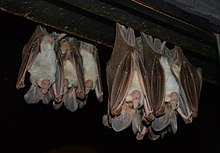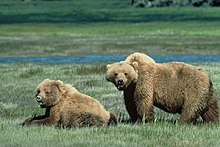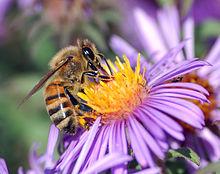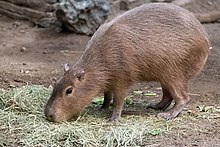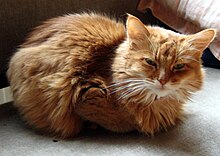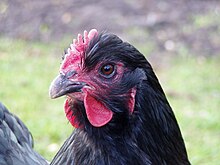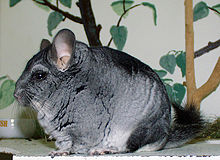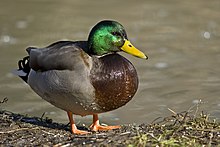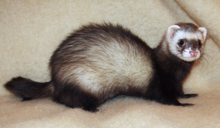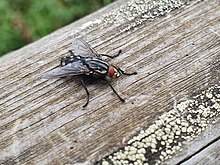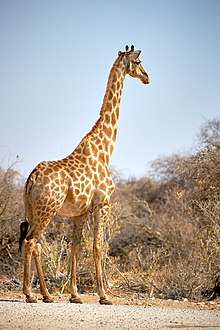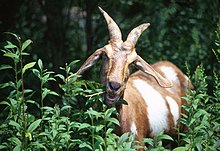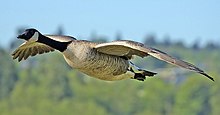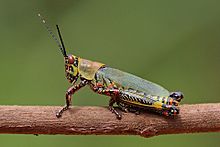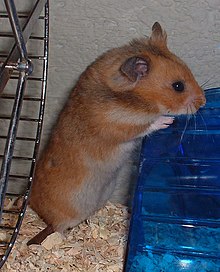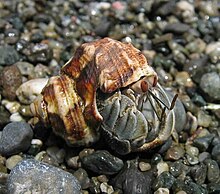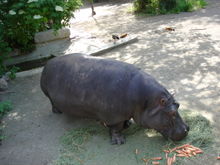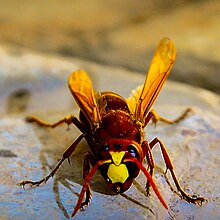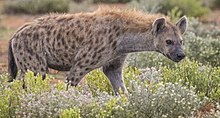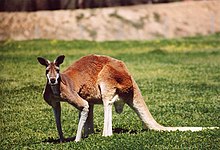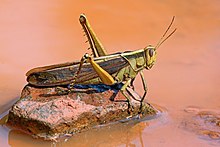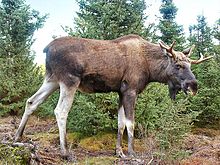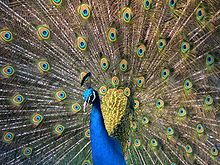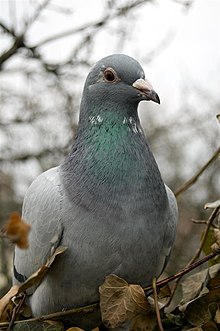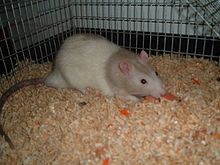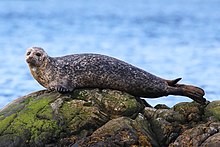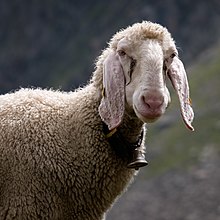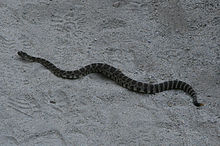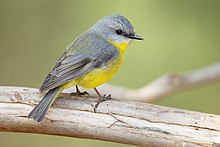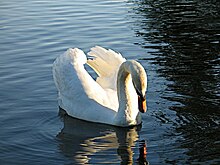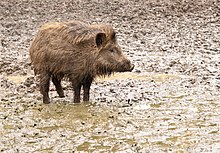
The cat, commonly referred to as the domestic cat or house cat, is a small domesticated carnivorous mammal. It is the only domesticated species of the family Felidae. Recent advances in archaeology and genetics have shown that the domestication of the cat occurred in the Near East around 7500 BC. It is commonly kept as a house pet and farm cat, but also ranges freely as a feral cat avoiding human contact. It is valued by humans for companionship and its ability to kill vermin. Its retractable claws are adapted to killing small prey like mice and rats. It has a strong, flexible body, quick reflexes, sharp teeth, and its night vision and sense of smell are well developed. It is a social species, but a solitary hunter and a crepuscular predator. Cat communication includes vocalizations like meowing, purring, trilling, hissing, growling, and grunting as well as cat body language. It can hear sounds too faint or too high in frequency for human ears, such as those made by small mammals. It also secretes and perceives pheromones.

A mammal is a vertebrate animal of the class Mammalia. Mammals are characterized by the presence of milk-producing mammary glands for feeding their young, a neocortex region of the brain, fur or hair, and three middle ear bones. These characteristics distinguish them from reptiles and birds, from which their ancestors diverged in the Carboniferous Period over 300 million years ago. Around 6,400 extant species of mammals have been described and divided into 29 orders.

Onomatopoeia is a type of word, or the process of creating a word, that phonetically imitates, resembles, or suggests the sound that it describes. Common onomatopoeias include animal noises such as oink, meow, roar, and chirp. Onomatopoeia can differ by language: it conforms to some extent to the broader linguistic system. Hence, the sound of a clock may be expressed variously across languages: thus as tick tock in English, tic tac in Spanish and Italian, dī dā in Mandarin, kachi kachi in Japanese, or tik-tik in Hindi and Bengali.
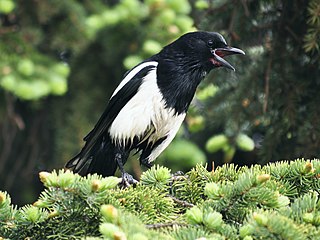
The black-billed magpie, also known as the American magpie, is a bird in the corvid family found in the western half of North America. It is black and white, with the wings and tail showing black areas and iridescent hints of blue and blue-green. It was once thought to be a subspecies of the Eurasian magpie, but was placed into its own species in 2000 based on genetic studies.
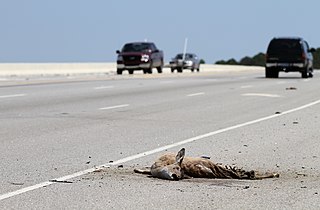
Roadkill is a wild animal that have been killed by collision with motor vehicles. Wildlife-vehicle collisions (WVC) have increasingly been the topic of academic research to understand the causes, and how they can be mitigated.

The serval is a wild cat native to Africa. It is widespread in sub-Saharan countries, except rainforest regions. Across its range, it occurs in protected areas, and hunting it is either prohibited or regulated in range countries.
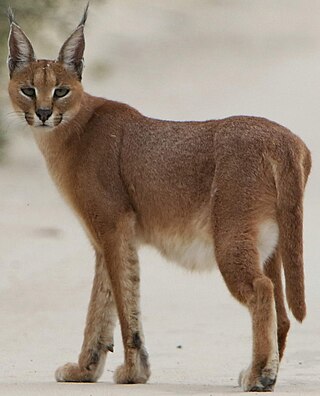
The caracal is a medium-sized wild cat native to Africa, the Middle East, Central Asia, and arid areas of Pakistan and northwestern India. It is characterised by a robust build, long legs, a short face, long tufted ears, relatively short tail, and long canine teeth. Its coat is uniformly reddish tan or sandy, while the ventral parts are lighter with small reddish markings. It reaches 40–50 cm (16–20 in) at the shoulder and weighs 8–19 kg (18–42 lb). It was first scientifically described by German naturalist Johann Christian Daniel von Schreber in 1776. Three subspecies are recognised.

The sea otter is a marine mammal native to the coasts of the northern and eastern North Pacific Ocean. Adult sea otters typically weigh between 14 and 45 kg, making them the heaviest members of the weasel family, but among the smallest marine mammals. Unlike most marine mammals, the sea otter's primary form of insulation is an exceptionally thick coat of fur, the densest in the animal kingdom. Although it can walk on land, the sea otter is capable of living exclusively in the ocean.
A purr or whirr is a tonal fluttering sound made by some species of felids, including both larger, outdoor cats and the domestic cat, as well as two species of genets. It varies in loudness and tone among species and in the same animal. In smaller and domestic cats it is known as a purr, while in larger felids, such as the panther, it is called a whirr.
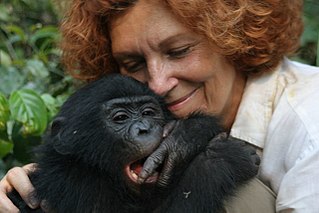
Human–animal communication is the communication observed between humans and other animals, ranging from non-verbal cues and vocalizations to the use of language.

The Malagasy or striped civet, also known as the fanaloka or jabady, is an euplerid endemic to Madagascar. It is the only species in genus Fossa.

Corvus is a widely distributed genus of passerine birds ranging from medium-sized to large-sized in the family Corvidae. It includes species commonly known as crows, ravens, and rooks. The species commonly encountered in Europe are the carrion crow, hooded crow, common raven, and rook; those discovered later were named "crow" or "raven" chiefly on the basis of their size, crows generally being smaller. The genus name is Latin for "raven".

Emotion is defined as any mental experience with high intensity and high hedonic content. The existence and nature of emotions in non-human animals are believed to be correlated with those of humans and to have evolved from the same mechanisms. Charles Darwin was one of the first scientists to write about the subject, and his observational approach has since developed into a more robust, hypothesis-driven, scientific approach. Cognitive bias tests and learned helplessness models have shown feelings of optimism and pessimism in a wide range of species, including rats, dogs, cats, rhesus macaques, sheep, chicks, starlings, pigs, and honeybees. Jaak Panksepp played a large role in the study of animal emotion, basing his research on the neurological aspect. Mentioning seven core emotional feelings reflected through a variety of neuro-dynamic limbic emotional action systems, including seeking, fear, rage, lust, care, panic and play. Through brain stimulation and pharmacological challenges, such emotional responses can be effectively monitored.

Cats communicate for a variety of reasons, including to show happiness, express anger, solicit attention, and observe potential prey. Additionally, they collaborate, play, and share resources. When cats communicate with humans, they do so to get what they need or want, such as food, water, attention, or play. As such, cat communication methods have been significantly altered by domestication. Studies have shown that domestic cats tend to meow much more than feral cats. They rarely meow to communicate with fellow cats or other animals. Cats can socialize with each other and are known to form "social ladders," where a dominant cat is leading a few lesser cats. This is common in multi-cat households.
The wildlife of Iraq includes its flora and fauna and their natural habitats. Iraq has multiple biomes from mountainous region in the north to the wet marshlands along the Euphrates river. The western part of the country is mainly desert and some semi-arid regions. As of 2001, seven of Iraq's mammal species and 12 of its bird species were endangered. The endangered species include the northern bald ibis and Persian fallow deer. The Syrian wild ass is extinct, and the Saudi Arabian dorcas gazelle was declared extinct in 2008.

Sea otter conservation began in the early 20th century, when the sea otter was nearly extinct due to large-scale commercial hunting. The sea otter was once abundant in a wide arc across the North Pacific ocean, from northern Japan to Alaska to Mexico. By 1911, hunting for the animal's luxurious fur had reduced the sea otter population to fewer than 2000 individuals in the most remote and inaccessible parts of its range. The IUCN lists the sea otter as an endangered species. Threats to sea otters include oil spills, and a major spill can rapidly kill thousands of the animals.

A meow or miaow is a cat vocalization. Meows may have diverse tones in terms of their sound, and what is heard can vary from being chattered to calls, murmurs, and whispers. Adult cats rarely meow to each other. Thus, an adult cat meowing to human beings is generally considered a post-domestication extension of meowing by kittens: a call for attention. Felines usually communicate with each other via their shared sense of smell, yet with people they often make verbal cues around behavior, such as having a specific sound indicate a desire to go outside.
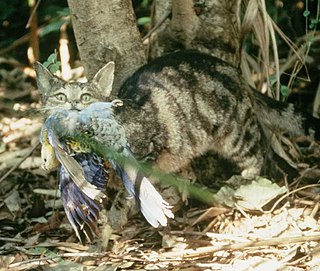
Cat predation on wildlife is the result of the natural instincts and behavior of both feral and owned house cats to hunt small prey, including wildlife. Some people view this as a desirable phenomenon, such as in the case of barn cats and other cats kept for the intended purpose of pest control in rural settings; but scientific evidence does not support the popular use of cats to control urban rat populations, and ecologists oppose their use for this purpose because of the disproportionate harm they do to native wildlife. As an invasive species and predator, they do considerable ecological damage.
Gisela Kaplan is an Australian ethologist who primarily specialises in ornithology and primatology. She is a professor emeritus in animal behaviour at the University of New England, Australia, and also honorary professor of the Queensland Brain Institute.




